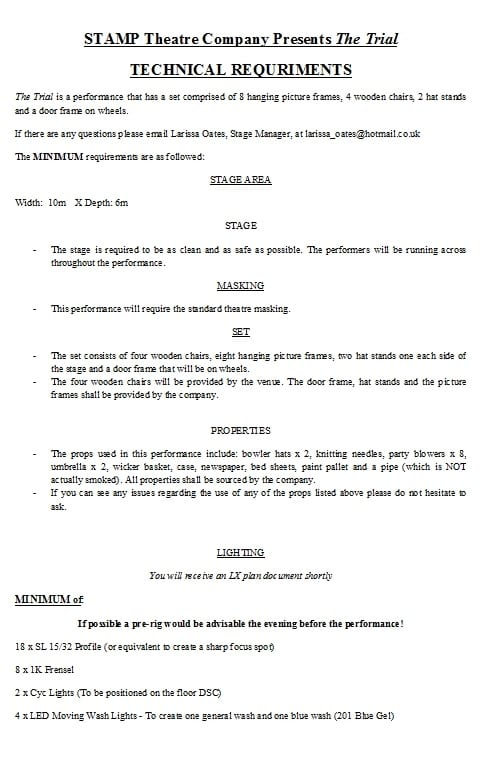To maintain a positive relationship between a Theatre Company and a performance Venue it is important that the company produce the necessary documentation. In this post I am referring directly to the Technical Rider. The Technical Rider is a form of documentation that provides the details of the specific requirements a touring company will need for their production, such as set, props and lighting. Peter Maccoy states in his book Essentials of a Stage Manager that “Technical riders are most effective when worded to be as helpful and informative as possible. The language should be simple rather than legalistic” (p.245). With Maccoy’s statement in mind I began creating STAMP Theatre’s Technical Rider.
It is important to send a company’s Technical Rider to the theatre a month in advance of the actual performance. This provides the technicians at the venue with time to prepare for the company’s arrival, especially if they will need to source any prop items or lights. In order to fill this out as detailed as possible I made contact with LPAC’s Stage Manager, Darren Page, and asked for a detailed document containing all the LPAC Technical Specifications:
From this document I was able to ascertain the width and height of the stage, the style of staging, storage space and the specific lights, all of which were helpful when drawing up STAMP’s Technical Rider and enabled myself to make any adjustments if necessary.
STAMP’s Technical Rider was as followed:The Trial Technical Rider
As you can observe from the document above, STAMP’s rider covered Stage Area, Set, Properties, Lighting, Operation, Time In Venue, Get Out and Secure Storage. These areas are important to specify clearly as the productions success relies on their accuracy. For STAMP Theatre my main concern was the building of the picture frames and the storing of the larger set objects. Although I had been to see Darren about them previously and he had kindly offered to attach the bungee cord and hang the frames from the top of the stage himself, I wanted to make sure Darren received all materials necessary to produce them. Along with Assistant Stage Manger, Alex Harvey Sporle, we sourced the materials necessary and gave them to Darren a month before the performance. On top of this the company needed somewhere to store the frames and bungee cord as well as the door frame and hat stands. From the LPAC Technical Specifications document I was able to surmise that there would be space to store these objects at LPAC and after discussing this with Darren the company was able to do so.
On completion of the Technical Rider I forwarded the document to Darren as soon as possible. As I previously mentioned it is important to provide the performance information to the venue in advance. In doing this I felt the company had an instant positive relationship with the LPAC staff allowing for the production set up to be a smooth transaction for all.
Thank you for reading,
Larissa
xxx
Work Cited
Maccoy, Peter (2004) Essentials of Stage Management, A & C Black Publishers Ltd.

